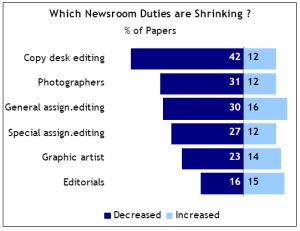PEJ Report – The Changing Newspaper Newsroom
The Project for Excellence in Journalism (funded by the PEW Charitable Trust) has an excellent report out on the Changing Newspaper Newsroom – with some very interesting statistics that seem to imply the newspapers still haven’t got the message about their value proposition.
It has fewer pages than three years ago, the paper stock is thinner, and the stories are shorter. There is less foreign and national news, less space devoted to science, the arts, features and a range of specialized subjects. Business coverage is either packaged in an increasingly thin stand-alone section or collapsed into another part of the paper. The crossword puzzle has shrunk, the TV listings and stock tables may have disappeared, but coverage of some local issues has strengthened and investigative reporting remains highly valued.

Well, that sounds good, but in looking at the graphics we see that the biggest area of cuts is what many point to as one of the two biggest differentiators with online journalism, the Copy Editor (the other is local coverage, which we’ll get to in a minute.
The thing in my mind is that you can’t hold the lack of editing up as the big problem with blogs, citizen journalism, or whatever you want to call it, then club your own copy editors like so many seals. They’re either important or they’re not.
As an experienced writer and blogger I can tell you that I am much better when I’ve got a competent copy editor to work with. Not only do they catch the typos, they’re the folks that ask “What are you, writing in esperanto? Say what you mean.” or “This section needs to be rewritten, it doesn’t say what you think it does.” It’s the reason I so often post here and am corrected in the comments section by my astute readers. The truth is, on a blog, you’re my copy editors.
As far as local reporting, the papers report devoting much more space to it, but in actuality, they are using less bodies to do it. While 62 papers reported devoting more space to local, only 8 said they used less space. However, half of the papers reported they had less “resources” assigned to local reporting. Again, it flies in the face of the protestations.
The real answer is that they’re devoting *proportionally* more space to local news, and have contracted both the overall number of “resources” they have available (magic decoder ring: resources were formerly known as “people” or “journalists” prior to the ascent of the accountants) as well as decreased the number of pages they’re publishing overall. There’s no mystery here, and the big news will be how this all works for them. Personally, I think the newspapers missed their opportunity in 2000, and they probably won’t be getting another one.
Robb Montgomery posted on the same issue:
If reporters are laid off and the paper doesn’t report their actions – did it really happen?
It is, perhaps, an unforgivable journalism sin that this story is not being told fully by some closely-watched U.S. newspapers. Reports from The New York Times and Editor And Publisher indicate that editors-in-chief of Tribune newspapers in Florida are neither announcing nor publishing the newsroom layoffs they are making at this very moment.From the E&P item: “Of concern to several staffers, however, has been the Sun-Sentinel’s lack of reporting on the cutbacks, with no stories appearing in the newspaper or on its Web site about the cuts. In most cases, newspapers have reported on their own cutbacks prior to the final reductions.”
Right on Robb – newspaper, cover thyself…to paraphrase the old saw about physicians. The wholesale carnage in the industry, while getting mention in blogs such as this, is generally going under or even un-reported. As I noted before, we’re talking about people, even if we cloak the humanity in terms like “resources”. And these actions while they may impact newspaper readers a little, are both “life and career altering events” for the people experiencing them. I know, I’ve been there, and over a year later, even though I’m well employed, I am still dealing with the vast ramifications, both personally and financially of that layoff.